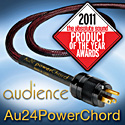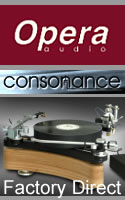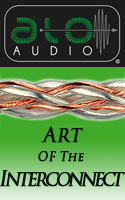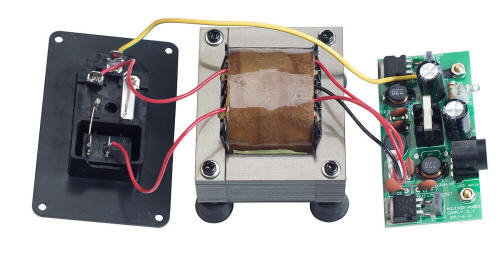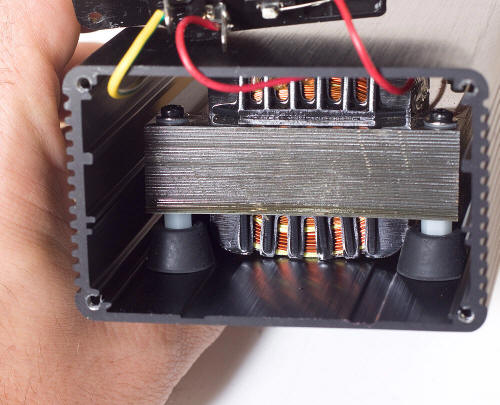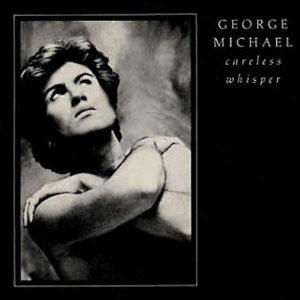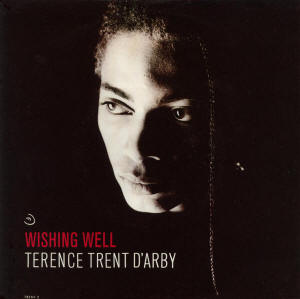|
|
You are reading the older HTML site
Positive Feedback ISSUE 60
pangea P-100 Power Supply - The Secret to Life is "One" as reviewed by Dan Dzuban
Wow, this was an easy review. I've already described the virtues of Cambridge Audio's amazing DACMagic in detail. Pangea's P-100 power supply is merely a $99 upgrade to Cambridge Audio's stock wall wart supply, and is compatible with other components such as several Music Fidelity products and other Cambridge Audio products. Yet according to Cambridge Audio, there is no additional benefit to be had by upgrading the power supply, so what is there to discuss?
The Pangea is a solid little brick of a power supply, more hefty and solid than what you would expect. Its marketing literature promises sonic improvements due to the PSU's choke filtering, high regulation, low noise, IEC cable connection, more substantial connectors, and design by component guru Peter Madnick (one of the main men behind Audio Alchemy of yore). Regardless of marketing claims, within five minutes of installing this new supply, and thereafter, as far as I can hear it only does one thing; it increases the signal to noise ratio considerably. That's it. I didn't hear any increase in bass or dynamics. No additional smoothness or reduction in sibilants. No additional liquidity through the midrange or increased sweetness through the treble. Just an increase in signal to noise ratio. Simple, huh? Is a single improvement a worthwhile upgrade? Well, it's not so simple because this one change brought with it substantial improvements to the DACMagic's overall performance.
The Specifics Stereo separation and soundstage size improved dramatically—both in terms of increased physical separation between sound sources within the soundstage, and in terms of an increased reverberant field surrounding each sound source. This is the kind of distinction I hear from a pair of monoblock amps versus a single stereo amp, and it is typically why I prefer monoblocks over a stereo amplifier. I don't understand why this should be, as I don't think there are dual mono power supplies in the DAC or the PS. There was no easy answer that I could think of, other than an increase in signal to noise ratio could reduce a layer of noise that obscured stereo cues that were otherwise present. And by "stereo cues" I mean a combination of low-level details such as faint echoes, and subtle phase cues that create a sense of location and distance.
Resolution increased dramatically as well, which would be consistent with improvements in signal to noise ratio. As discussed above, I didn't hear any difference in tonal character with the addition of the Pangea unit. This brought an unintended benefit; the DACMagic previously was never harsh or fatiguing tonally, so now all this additional musical detail and resolution was presented without detracting in any way from musical reproduction. So in addition to "stereo cues" such as faint echoes, I was able to hear more detail in the sound made by the instruments themselves. Drums in particular sounded much more complex. Instead of a single "thump", I could hear the hollowness of a drum's body, as well as the metallic ring of its frame, and the sound of its skin—all simultaneously when struck. Vocals were more easily distinguished within the soundstage, more palpable, more starkly lit by a proverbial spotlight. These phenomena aren't ground breaking in themselves—I am sure hundreds of components are capable of doing this. But none at anywhere near the combined $500 price for the DACMagic and Pangea power supply combo. It's standard audiophile fare to discuss how high resolution audio systems make bad recordings sound unbearable, and its equally as overdone to discuss systems that euphonize bad recordings to the point of sounding acceptable. But what about systems that let recordings sound good? One of my favorite pursuits within this hobby of ours is to reexamine recordings that should not sound good, but can, once you have uncovered otherwise hidden traits within the recording. Sure, you can find any number of minimalist audiophile recordings that sound spookily alive on a good system, but what about the pop recordings that are over-processed, flat, lifeless, and ignored within audiophile circles? For example, I am now in awe of Wham!'s Careless Whisper (Columbia Records/12" Single/1984). It is not considered an audiophile recording. Hell, it's generally not even my taste in music, and I barely realized that I owned it, as it was just one song among hundreds included in my numerous prepackaged 80s compilations. But the recording was dripping with ambiance through the Pangea-supplemented DACMagic. It wasn't just that I could hear instruments and George Michael's voice more clearly through a three-dimensional sound stage, but the air between and around them was thick with a reverberant liveliness that stopped me in my tracks (so to speak).
The same was true with Terance Trent D'Arby's Wishing Well (Columbia Records/Introducing the Hardline According to Terence Trent D'Arby/1987). D'Arby's voice is very sibilant on this recording, but his voice is very distinctive and it stands out starkly within the soundstage. The song is mostly synthesizer-based, so it is hard to tell if I even should be hearing ambience, yet the swirling sounds coming from different points of the huge soundstage made it blast to listen to. I suspect much of the ambience I heard was from the increased stereo imaging effect brought to the table by the Pangea. I don't know if this technically counts as "natural" ambiance from a recording or not, but it sure made for an enjoyable experience. Conclusion - Inspired by Curly Certainly, my system's surrounding cast of Lexicon, Magnepan, and the excellent Odyssey Khartago SE amp had a hand in the spectacular sound I was getting. Yet to once again lean on the logic I used in my review of the Emotiva UPA-2—the other components could not be "propping up" the sound of the DACMagic/Pangea combo; the other components instead allowed the combo to perform at its potential. In this regard, I stand a bit corrected; not for one second had I considered that the DACMagic was the bottleneck for my system, given how it had impressed me initially. However, if the total performance of my system could jump up this much with the addition of "just" a new power supply, what does this say? This really was an easy review. As clear an improvement as the Pangea P-100 power supply made, it was all the more emphasized when I unplugged the Pangea and switched back to the stock power supply. Remember all of those improvements? Poof, they were gone. The $100 that this will cost you to add the Pangea to a DACMagic has to be considered a necessary cost when deciding whether to purchase the DAC, because the combined performance of both components far exceeds what you would ever expect from the sum of both their individual prices. With inspiration from Jack Palance's character "Curley" in the film City Slickers, the decision whether to upgrade your Cambridge Audio's DACMagic begins and ends with a simple, but definitive "Yes!" Highly recommended. Dan Dzuban Is available from a variety of vendors, so just do a search for Pangea P-100.
|
